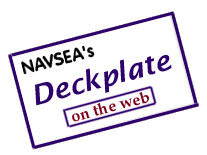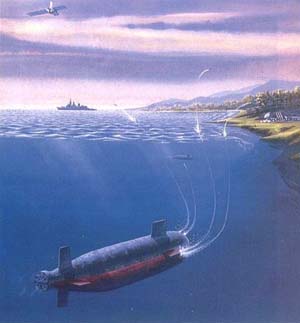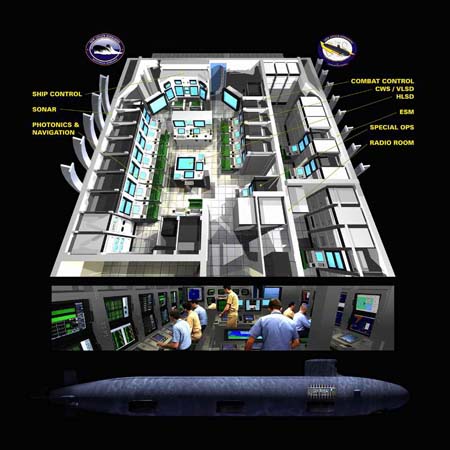 |
Issue
No. 1 / Jan-Feb 1999 |
Feature
|
||||||||
|
|
||||||||||
|
The Virginia Class—A
New Submarine for the 21st Century
You’ve probably heard about the U.S. Navy’s newest nuclear powered submarine, USS Seawolf (SSN 21). Perhaps you read about her in the newspapers, or read the articles in the Fall 1997 issue of Deckplate, or watched the documentary on cable television’s The Learning Channel. But have you heard anything about the Navy’s next generation submarine, the Virginia Class attack submarine? The Next-Generation Submarine The Virginia Class submarine will provide the U. S. Navy the capabilities required to maintain the nation’s undersea supremacy well into the 21st century. It will have improved stealthiness, sophisticated surveillance capabilities, and special warfare enhancements to meet the Navy’s multi-mission requirements. This next-generation submarine is the first U.S. submarine class to be designed for battlespace dominance across a broad spectrum of regional and littoral missions as well as open-ocean, “blue water” missions. It will achieve the right balance between core military capabilities and affordability. The construction contract for the first four Virginia Class submarines was awarded on September 30, 1998, to Electric Boat Corporation, with Newport News Shipbuilding serving as the major subcontractor. Under the construction contract, and consistent with a unique teaming plan, the shipbuilders will alternate final assembly and testing of the four ships. Newport News will build the bow, stern, sail, and selected forward modules for each submarine, while Electric Boat will build the hull cylinders, the engine room modules, and the command and control system module. Both shipbuilders will fabricate reactor compartments for the ships they assemble. This construction teaming plan is shown in the pictorial below.
The first and second of the new fast attack submarines, SSN 774 and SSN 775, have been named USS Virginia and USS Texas, respectively. Names for the later two submarines have not yet been announced. Multi-Mission Operations and Operational Flexibility The Virginia Class submarine is being designed for multi-mission operations and enhanced operational flexibility. Seawolf Class quieting is being incorporated in a smaller hull, while military performance will be maintained or improved. The Virginia Class submarine is being engineered for maximum design flexibility. Its responsiveness to changing missions and threats, and the affordable insertion of new technologies, ensures that it will continue to be the right submarine well into the 21st century. Integrated electronic systems with Commercial-Off-The-Shelf (COTS) components facilitate state-of-the-art technology introduction throughout the life of the Virginia Class submarine and avoids unit obsolescence. The Command, Control, Communications, and Intelligence (C3I) electronics packages also promote maximum flexibility for growth and upgrade. Coupled with the Modular Isolated Deck Structure (MIDS) and open-system architecture, this approach results in a significantly lower cost, yet more effective command and control structure for fire control, navigation, electronic warfare, and communications connectivity.
Features The Virginia Class submarine’s sonar system will be state-of-the-art with vastly increased signal processing power than today’s attack submarine! The system will be able to process and distribute data received from its spherical bow array, high-frequency array suite, dual towed arrays, and flank array suite. The Virginia Class submarine C3I prime contract was awarded to Lockheed Martin Federal Systems, Manassas, Virginia, in April 1996. This system, through its extensive use of COTS and open system architecture, is a pace setter on achieving breakthroughs in system affordability and flexibility. This innovative approach will achieve new performance standards while minimizing risk, and promoting new levels of extended contractor responsibility and participation in the maintenance and upgrade of the system over its life-cycle. The sail configuration houses two new photonics masts for improved imaging functions, an improved electronics support measures mast, and multi-mission masts that cover the frequency domain for full-spectrum, high data-rate communications. The sail is also designed for future installation of a special mission-configurable mast for enhanced flexibility and warfighting performance. The Virginia Class Ship Control System (SCS) provides all the control and monitoring functions for maneuvering and controlling ship dynamic operations. Included in the technology strategy for the SCS is fly-by-wire. Similar to advanced aircraft, fly-by-wire architecture is a control system which relies on redundant electronic data buses operated by a fault tolerant set of processors to control the operator’s commands to the control surfaces actuators. This replaces the past exclusive use of hydraulic controls between the ship control station and control surfaces. The Virginia Class submarine will be armed with a variety of weapons, including the most advanced heavyweight torpedoes, mines, Tomahawk cruise missiles, and Unmanned Undersea Vehicles (UUVs) for horizontal launch. In addition, Tomahawk missiles will be carried in vertical launch tubes. The submarine also features an integral Lock-Out/Lock-In chamber for special operations, and can host Special Operations Forces underwater delivery vehicles. Reducing Costs Reducing acquisition and life-cycle costs is a major objective of the Virginia Class submarine design and engineering process. Substantial cost avoidance is being achieved through the application of concurrent engineering design/build teams, computer-aided design and electronic visualization tools, system simplification, parts standardization, and component elimination. These innovations ensure that the ship will be affordable in sufficient numbers in order to satisfy America’s future nuclear attack submarine force level requirements. The end result is an extremely versatile weapon system at a nearly 30 percent reduction in follow ship cost. The Virginia Class Submarine Program Office is applying the lessons learned from successful Government and industry programs of similar scope and complexity to improve producibility and lower costs. Integrated Product and Process Development (IPPD) teams are bringing the combined experience of the shipbuilders, vendors, designers, engineers, and ship operators to bear on the ship design. The early involvement of production personnel on these teams ensures an excellent match between the design and the shipbuilder’s construction processes and facilities, allows a smoother transition from design to production, and reduces the number of engineering change orders typically required during lead ship construction. The ship is designed using a state-of-the-art digital database, which allows all members of the IPPD teams to work from a single design and provides three-dimensional electronic mock-ups throughout the design process. In order to provide cost-effective production of Virginia Class submarines, a co-production (teaming) arrangement has been established utilizing the combined strengths of Electric Boat Corporation and Newport News Shipbuilding. This co-production arrangement fits with each company’s independent objective of maintaining its technological skills, operational capacity, facilities, and other strengths in the design and construction of submarines, while offering the Government the best combination of performance, cost, and delivery. Cost effectiveness is realized through an integrated ship’s construction workscope split that allows for steeper learning curves at each shipyard, more efficient rollover of trades, and reduced second yard planning efforts. These efforts, along with strong support from Navy and shipbuilder management, will result in an affordable submarine that satisfies all operational needs. Performance The military performance of the Virginia Class submarine will be comparable to that of the Seawolf Class, with significant improvement in littoral warfare capabilities and considerably less cost. It will surpass the performance of any current projected threat submarine, thus ensuring U.S. undersea dominance well into the next century. And the develop-design-build process that the Virginia Class submarine program has created will be the role model for future Navy design efforts. Additional Information For more information, visit the Virginia Class attack submarine web site: www.nssn.navy.mil . Patrick Connor is the Assistant for Technical Requirements in the Procurement Branch of the Virginia Class Attack Submarine Program. |
||||||||||



